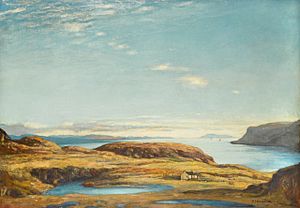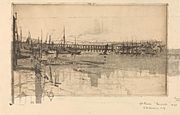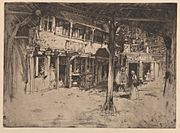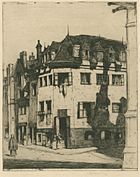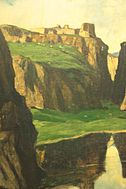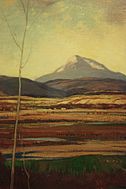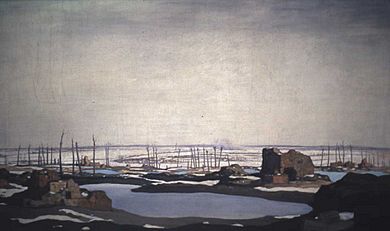David Young Cameron facts for kids
Quick facts for kids
David Young Cameron
|
|
|---|---|
| Born | 28 June 1865 |
| Died | 16 September 1945 (aged 80) |
| Nationality | Scottish |
| Education | Glasgow School of Art, Edinburgh Schools of Art |
| Known for | landscape painting, etching |
Sir David Young Cameron (born June 28, 1865 – died September 16, 1945) was a famous Scottish artist. He was well-known for his paintings and especially for his etchings, which are a special type of printmaking. He often created pictures of towns and beautiful landscapes. David Cameron was a very important artist during a time when etching became popular again.
Contents
A Look at David Cameron's Life
David Young Cameron was born in Glasgow, Scotland. He went to school at The Glasgow Academy. Later, he studied art at the Glasgow School of Art and the Edinburgh Schools of Art.
Becoming a Master Etcher
David became very good at etching, a special way of making prints. By the 1890s, people all over the world knew his name because of his amazing etchings. He joined the Royal Society of Painter-Printmakers in 1889 and became a full member in 1895. He showed his work often until 1902.
His etchings often showed buildings and landscapes. He won many awards for them! He even made collections of etchings, like "The Clyde Set" and "The North Italian Set." His prints often had dark areas with bright highlights. Later, he became known for his pictures of church insides and the wild, empty landscapes of Scotland. These were made using a technique called drypoint, which gave them a light, feathery look.
People really wanted to collect his art. However, when the Great Crash of 1929 happened, the prices for art prints dropped a lot. David Cameron was known for making many different versions of his prints. In one case, he made 28 different versions of the same print!
His Paintings and Style
Besides being a famous etcher, David Cameron also created many oil paintings and watercolour sketches. These also showed landscapes and buildings. His first known oil painting was made in 1883. His art was influenced by other artists like the Glasgow Boys and the Hague School.
When he first showed his paintings, some people liked them, but others thought they focused too much on decoration and not enough on deeper meaning. This was partly because he liked to make his subjects seem very romantic. After 1900, he stopped painting people and focused only on landscapes and buildings in both his paintings and etchings.
-
The Clyde near Carmyle, an etching from 1889.
-
Berwick, an etching from 1890.
-
Cour des Bons Enfants, Rouen, an etching from 1897.
-
Beauvais, a drypoint from 1910.
Life in the Highlands and Beyond
In 1899, David Cameron and his wife moved to Kippen in the Scottish Highlands. This village was close to Stirling, with amazing views of Ben Lomond and Stirling Castle. They lived there for the rest of their lives, but also had a house in London. They often traveled to places like Italy and France. Italy inspired many of his etchings of buildings, especially church interiors. His etchings, which played with light and shadow, showed influences from other famous artists like Whistler and Rembrandt.
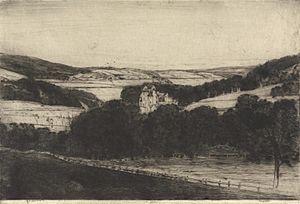
Joining Art Societies
David Cameron was very active in the art world. In 1901, he joined a group called the International Society of Sculptors, Painters and Gravers, which was started by Whistler. He showed his art with them and later helped lead the group. After leaving another society, he and 11 other artists formed The Society of Twelve in 1904 to promote original prints.
He also became a member of the Royal Society of Painters in Watercolours in 1906. He was elected to the Royal Scottish Academy (RSA) in 1904 and became a full RSA member in 1918. He also joined the Royal Academy (RA) in London, first for his etchings in 1911, then for his paintings in 1916, and became a full Royal Academician in 1920. His art was shown in many galleries across the UK and in other countries.
Changing Focus and Recognition
After 1907, David Cameron started to focus more on Scottish landscapes in his art. From 1908 to 1917, he painted more than he etched. Around this time, he mostly stopped including people in his pictures, except for his studies of buildings. His work was becoming very popular and praised by critics in the UK and abroad.
Around 1908, his paintings started to use lighter colors. Before this, some people thought his work was too dark. Trips to France and Italy in the 1920s seemed to make his colors even brighter. His paintings are known for their focus on light and design rather than just bright colors or tiny details. He became famous for his beautiful, moody landscapes of the Scottish Highlands.
David Cameron was well-liked and respected in the art world. He held many important positions in different art groups. He was even asked to be the president of the Royal Scottish Academy, but he said no because he already had too many responsibilities in London.
In 1917–18, the Canadian Government asked him to paint scenes from the war in France. In 1924, he was knighted, which means he received the title "Sir." He also served as a Trustee for the Tate Gallery and the Scottish National Gallery. From 1933, he was the King's Painter and Limner in Scotland, a special role for an artist.
Sir David Young Cameron passed away in Perth, Scotland on September 16, 1945.
Images for kids



